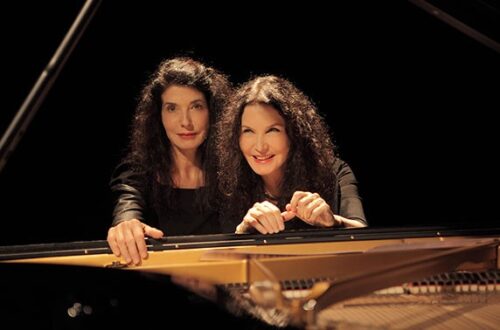 United Kingdom Glass, Adams: Katia and Marielle Labèque (pianos), Philharmonia Orchestra / Lawrence Renes (conductor). Royal Festival Hall, London, 21.10.2021. (CC)
United Kingdom Glass, Adams: Katia and Marielle Labèque (pianos), Philharmonia Orchestra / Lawrence Renes (conductor). Royal Festival Hall, London, 21.10.2021. (CC)

Glass – Prelude to Akhnaten (1982/3); Les Enfants Terribles (arr. Michael Riesman, UK premiere, 1996/2020); Double Concerto (2015)
Adams – Doctor Atomic Symphony (2007)
Part of the Philharmonia’s Human/Nature: Music for a Precious Planet series, the original plan for this concert was to present the momentous film by Godfrey Reggio and Ron Fricke with music by Philip Glass, Koyaanisqatsi (last seen in the Barbican Cinema, not with live orchestra, but as part of a festival that included the Labèques in the UK premiere of the Double Concerto: see review). But COVID-related traveling restrictions meant the Philip Glass Ensemble, originally scheduled to perform in this concert alongside the Philharmonia, was unable to make it across the Pond. Cue Glass’s Double Concerto and, stretching the envelope to post-Minimalism, John Adams’s Doctor Atomic Symphony.
Glass’s score for Akhnaten omits violins; the score is darkly hued, almost mahogany. Such a soundworld suits the Rolls Royce of English orchestras, the Philharmonia. Perhaps the Prelude purred along just a touch too smoothy, though; after the recent ENO Satyagraha (review click here), this felt a touch tame (but I wonder if the two trombones/tuba entrance has ever sounded creamier?).
No such issues with the performance by the Labèque sisters of Glass’s Les Enfants Terribles, music from Glass’s ‘danced chamber opera’ (based on Jean Cocteau) superbly and sensitively arranged by Michael Riesman. The recording by the Labèques of this for DG is a miracle of performance; but somehow this account trumped it. Perhaps it was the occasion of its UK première, but the sisters, surely the perfect piano pairing, somehow took the excitement of the piece to greater heights. The bass gestures of the opening movement contained huge power, the dreamier second panel made ever more profound by Marielle’s tolling bass. Despite the dreamier atmosphere, though, this was crystalline playing, every detail audible and clear. Hearing the careful articulation of ‘She slapped me’ took us to the other side of Glass, a fragile kinetic energy that has the potential to go anywhere. From the grandeur of ‘They lived their dream’ to the whispered mysteries of ‘Terrible Interlude’ to the additive textures of ‘Cocoon of Shawls,’ to the desolation of ‘Lost’ (where the tolling bass is changed to tolling mid-range chords that pulse over ominously descending basslines), to the unrest of ‘Are you in love, Agatha?’ and its supremely even trills from both pianists, this was an utterly remarkable performance.
Post-interval, the piece that had received its UK premiere at that Barbican festival, the Double Concerto for Two Pianists and Orchestra of 2015, which was expressly written for the Labèque sisters. The Double Concerto could hardly be more different than Les Enfants terribles: Afro-Caribbean rhythms dominate the first movement, sometimes outrageously. It does need an unbuttoned performance (such as the duo’s recording with the Los Angeles Philharmonic and Gustavo Dudamel on Orange Mountain Music), Interesting to hear how Glass at once celebrates – then subtly subverts through his repetitions – those rhythms; even deconstructing them by taking a shard and passing it between pianos and orchestra as if they were passing a parcel. This was a good performance, orchestra and pianos very much on the ball; but is the score Glass at his finest? When I heard the piece at the Barbican, I described the first movement as ‘Milhaud-meets-Glass’; a little less of the piquancy of Milhaud in this Philharmonia performance, perhaps. The second movement feels the weakest of the three, compositionally; a greater sense of underlying tension might have saved it. By some margin, the slow finale is the finest movement: it feels as if one has ‘arrived’. This is ‘Glass noir’, most effective is the prevalent keening gesture that is appended to the slow oscillations. Perhaps the performers felt this deepening, too, as this was the finest account of a movement of the piece. But one third of a piece does not a piece make.
Finally, somewhat off-piste with John Adams’s Doctor Atomic Symphony (2007), with music from his opera Doctor Atomic (see here for my review of the 2017 Barbican performance conducted by the composer). When it was first performed in 2007, the symphony had four movements; Adams has subsequently cut the one called ‘Bedroom’, leaving us with ‘The Laboratory,’ ‘Panic’ and ‘Trinity’. If ever there was a way to demonstrate Glass’s superiority as a composer over Adams, it is to directly juxtapose the two. Overtly gestural and yet with little substance, ‘The Laboratory’ is a sequence of effects. Its opening seems to reference Brahms’s First Symphony with the repeated, pounding percussion, but in comparison with Henze’s masterly recontextualising of that same moment in his Tristan (1973, piano, tape and orchestra), Adams’s attempt dissolves into nothingness. The first movement feels at times like Adams’s Concerto for Orchestra, but with no meat to it. The central ‘Panic’ is virtuoso – and there are few orchestras more equipped for its demands than the Philharmonia, here on top form, the strings immensely disciplined at huge velocity. The finale is taken from the end of the first act, Adams’s setting of John Donne’s astonishing ‘Batter my heart’ – the strongest part of the opera – now with vocal line on trumpet. Superbly played though the trumpet line was, there was perhaps a feeling that the players as a whole were not completely involved in this music.
But it is for the Glass that most will have come, and no one can doubt the high quality of those performances here.
Colin Clarke
